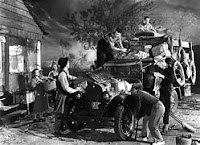"The opposite of 'racist' isn't 'not racist.' It is 'antiracist.' What's the difference? One endorses either the idea of a racial hierarchy as a racist, or racial equality as an antiracist. One either believes problems are rooted in groups of people, as a racist, or locates the roots of problems in power and policies, as an antiracist. One either allows racial inequities to persevere, as a racist, or confronts racial inequities, as an antiracist. There is no in-between safe space of 'not racist.' The claim of 'not racist' neutrality is a mask for racism." -Ibram X. Kendi, from How to Be an Antiracist
After the death of George Floyd at the hands of police in May brought on a rash of protests and a reenergized Black Lives Matter movement, some of our church members felt compelled to DO something. In the midst of the COVID pandemic, it did not seem safe to be protesting among crowds of people but we could definitely start listening, reading and discussing the racial problems facing our community and nation. We decided to meet once a week to discuss parts of How to Be an Antiracist, which had been a NYT nonfiction bestseller. We read and discussed 2 chapters per week, starting at the end of August. I have learned a great deal from the book so I could easily rate it a 5 for its educational value and the amazing research it took to write. There were parts I thought were wordy and repetitive and others that were intellectually over my head making for arduous reading. There were some very interesting parts where Kendi shares his memories and life experiences, so for entertainment, my rating is 3. Overall I give the book a 4. I am glad I read it. I am not sure I would have finished if it had not been for the stimulating discussions of our group each week.
I felt the quote above which comes near the beginning of the book is a good introduction to Kendi's content. Rather that setting himself up as a know-it-all on this subject, Kendi shares his journey of self-reflection and how he discovered the many racist beliefs he had held. I believe he is asking the reader to do some of this same personal evaluation.
One point that Kendi makes loud and clear is that judging a whole group of people by the actions of individuals is wrong. He wants us to know it is not groups of people that are the problem; the problems lie in unequal power and inequitable and unjust policies. The author stresses it is not enough to say "I am not a racist," we must become "antiracists." This means we must identify racist ideas and policies and stand against them.
It was surprising that there are so many ways in which racism is revealed---power, biology, ethnicity, body, culture, behavior, color, whiteness, blackness, class, gender and sexuality---all treated in separate chapters of the book. I found an interesting summary: "6 Ways to to Be an Antiracist Because Being 'Not Racist' Isn't Enough" by Rebecca Ruiz from the "Amplify" series. Here is the link:
https://mashable.com/article/how-to-be-antiracist/





